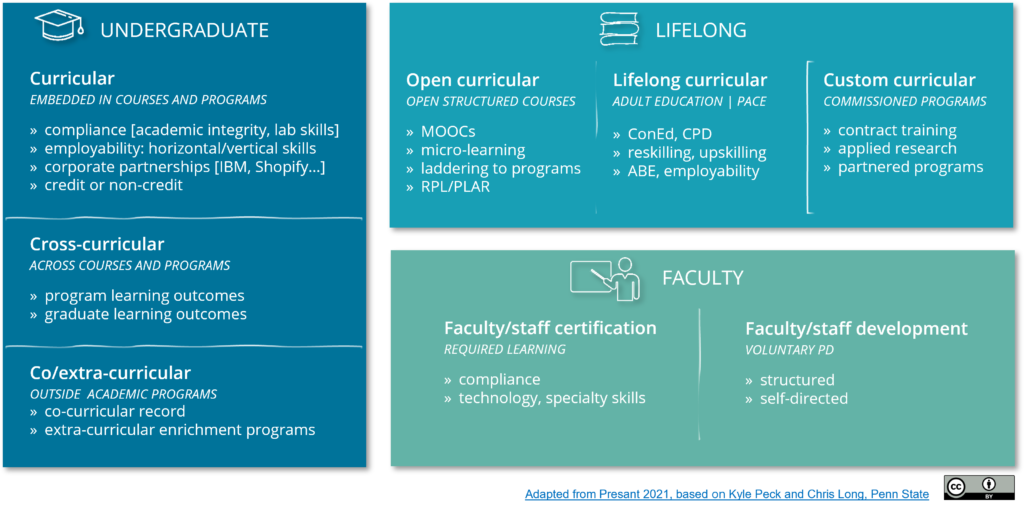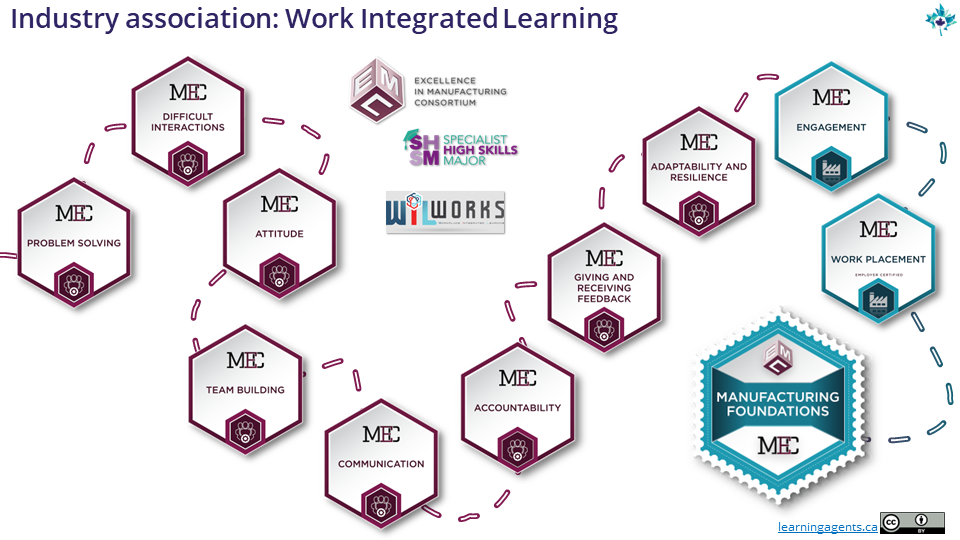Thanks to Noah Geisel for sharing a version of this RAND/UMichigan report the other week:

Stackable Credential Pipelines and Equity for Low-Income Individuals – Evidence from Colorado and Ohio (2023)
It’s helped me understand a little better why so many academics keep talking about stacking badges into undergraduate degrees, which I’ve always thought was a very problematic use case for badges, given all the complexities of articulation, transfer and program mapping, even across departments within an institution, much less across institutions.
I usually encourage people to think about how to showcase, enhance, extend and refresh diplomas and degrees with additional learning that can be stacked for credit and/or industry recognition, or “embedded learning” extracted from longer academic programs (e.g. science or technology skills that will “pop out” in a résumé). I’ve always felt that stacking for industry recognition or even for post-grad certificates would be easier than for undergraduate degrees.
But the title of the report caught my eye, along with this quote:
Earnings gaps shrunk when low-income individuals earned certificates (shorter-term occupational credentials) and then went on to earn degrees.
Who wouldn’t want that? Could I have been wrong (gasp!) in advising people away from stacking credit-based badges into degrees?
But then I read further, and learned more: the history of stackable credentials provides a coeval context for why Open Badges have been so often framed as stackable micro-credentials when that’s just one thing they could do, i.e. act as a digital containers for certificates of various types and sizes – note the dates:
“States and institutions across the United States are pursuing initiatives that support the design of stackable credentials, defined by the U.S. Department of Labor as a “sequence of credentials that can be accumulated over time to build up an individual’s qualifications and help that individual move along a career pathway to further education and different responsibilities, and potentially higher-paying jobs” (Employment and Training Administration, 2010, p. 6).
…
“Stackable credentials have been growing in popularity since the mid-2000s and are an important focus of many state and institutional initiatives to strengthen applied programs in fields such as health care, IT, and advanced manufacturing. These programs aim to open more pathways into and through postsecondary education for historically underserved populations, including low-income individuals.”
So, educators in the US in the mid-2000s, before Open Badges were invented, were already speculating and experimenting with better ways to help low-income learners advance their education incrementally, by moving from technical college certificates into community college diplomas and maybe even into undergraduate degrees. That’s laudable.
Then along come Open Badges in 2011.. how convenient for stackable certificates! And then, well, blockchain of course, because every single component of that stacked credential now HAS to be authenticated, right?
But how limiting for Open Badges, as all the reusable recognition oxygen gets sucked from the landscape of recognition:

… and gets pumped into “modular diplomas”, with all the gnarly baggage of credit articulation, transfer and program recognition, now at a micro level like mismatched Lego bricks across programs and institutions, along with new vocabulary such as “horizontal” and “vertical” and “lattice” to further complicate and confuse. Speaking of which: is a digital badge not good enough to be a micro-credential, or just not big enough? Asking for a friend…
I submit to you that there’s a big difference between stacking a 6-month program certificate into a 1-year certificate into a 2-year diploma into a 4-year degree… (which is what RAND and UMichigan are mostly tracking in their report – very little mention of badges) and trying to do all that with credential units that can go down to a 1-hour micro-credential in Australia, for example. It’s a lot easier to stack credits or 30 or 60 at a time than 1 or 3 or 6 at a time.
I actually support badge stacking, but smaller stacks and clusters, and well beyond academic programs: industry-facing “employment ready” stacks, for example, that can combine knowledge, application, reflection and field experience.
Here’s one from Excellence in Manufacturing, for example:

I’d love to see a follow-up to this RAND report, one that interviews not just academic leaders, but also students about why they made their stacking choices (or not) and also asks employers how they rate the importance of stacked credit to their skills needs. Industry research interviews I was involved in with employers in 2021/2022 indicates that employers and industry bodies are far more conscious of the brand and reputation of educators as a signal of quality than they they are in complex discussions of credit and accreditation, and they’re understandably less concerned about macro-credentials than are institutions.
I like to say that:
Open Badges > Micro-credentials > Digital Certificates
In other words, Open Badges can recognize and enable lots of things, which is both a blessing and a curse for the flexible credentialing standard. Focusing on credit-based micro-credentials stacking into academic macro-credentials like diplomas and degrees can be a big distraction from other important value that micro-credentials can provide, such as contextual authenticity, industry relevance and demonstration of competency.
… not to mention the social recognition value and community connection that can come from less formal types of badges that are not assessed for credit…



